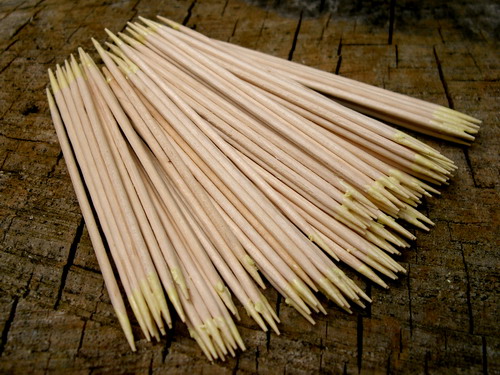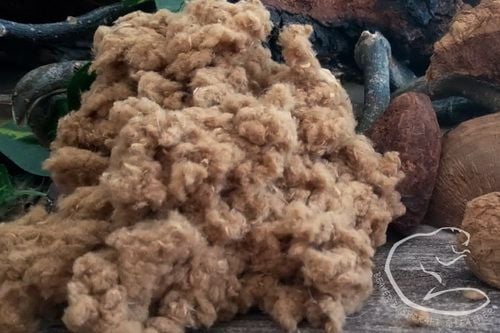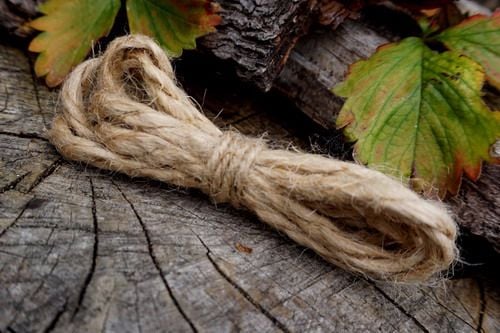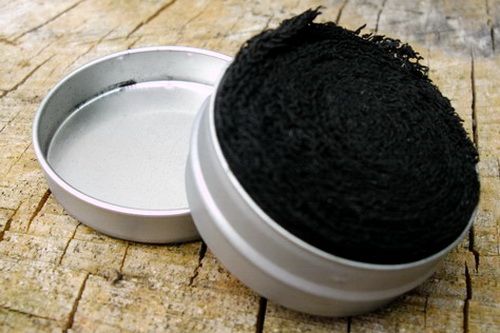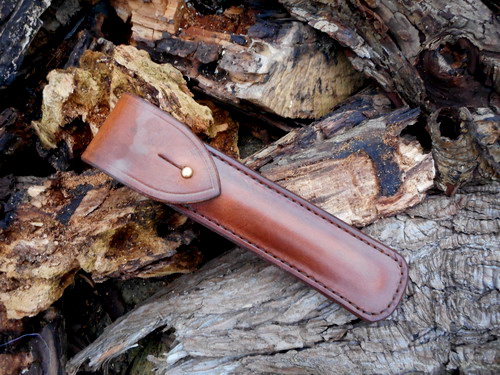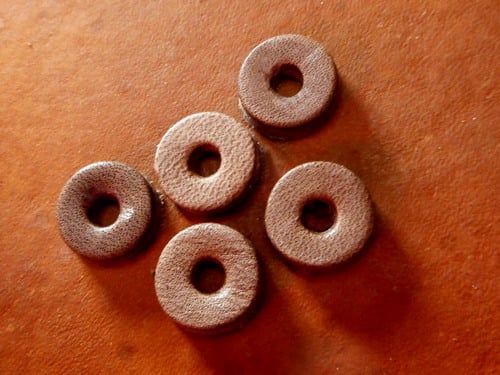
- Bushcraft Tools - Fire Piston Spares - Rubber & Traditional Leather Grommet
- Bushcraft Tools - Fire Piston Spares - Rubber & Traditional Leather Grommet
-
Fire Piston Spares - Traditional Leather Grommets (47-1010)
- Available Now
- £3.50
- FREE UK Delivery
- Beaver Bushcraft - Traditional Leather Grommets - 5 per pack (47-1010)
PLEASE NOTE:
- This listing is for Spare Parts for the Bushcraft Tools - Aluminium Pyro-Piston Fire Piston only.
- The Fire Piston and other items shown in these photos are for demonstration purposes only and not included in this sale.
The Bushcraft Tools - Pyro-Fire Piston is one of the most economically priced fire pistons that we have come across in all of our years of fire lighting demonstrations, yet performs at the specifications required to make consistent and reliable embers.
Traditional Leather Grommets Vs. Rubber Grommets
Our handmade Traditional Leather Grommets are just as effective as the Rubber Grommets, however they are much more substantial and will last considerably longer that the Standard Rubber Grommets that were originally supplied with your piston.
Traditional Leather Grommets have been used for centuries to create airtight seals in such items a bicycle hand pumps, air-rifles and water pumps etc. Leather Grommets are both reliable and known for their durability and dependability in such applications.
The down side of using a Traditional Leather Grommet, is that it will need to be moulded to the Fire Piston before the piston can be used, however, this only takes a few minutes and the benefits of using Traditional Leather Grommets over its more modern Rubber counterpart will quickly and drastically outweigh the extra time it take to fit them.
Whilst Rubber grommets are cheap and relatively fast to replace, they are a lot more fragile than leather, being prone to pinch damage caused when the Piston is inserted into the Barrel as well as wearing out faster in use.
If the air inside the Piston’s Barrel is to be compressed sufficiently to cause the Tinder that is held at the end of the Piston’s Tinder Cup is to spontaneously ignite, it is essential that whichever Grommet (i.e. either a Traditional Leather Grommet or a Rubber Grommet) is employed in the Fire Piston be properly lubricated before use.
Whilst Rubber Grommets requires the exclusive use of animal or mineral based lubricants such as oils, fats, some soft waxes and of course the commonly used Petroleum Jelly; Leather Grommets have the advantage, since theycan also be used with water or saliva at a pinch.
The Video (below) demonstrates how the Standard and Traditional Leather Grommets are best fitted to a Bushcraft Tools - Fire Piston.
Video: The Fire Piston - How to Fit a Leather Grommet
Initially, the Leather Grommets will require to be moulded to the specific diameter of the Piston’s Barrel. This is done by soaking the Leather Grommet in water and then attached to the Fire Piston’s Screw-In Tinder Cup. The Screw-In Tinder Cup is then screwed onto the Piston Rod so that the leather is snug against the Piston Rod and Tinder Cup. Laying the Piston Rod on its side and on a flat hard surface the Leather Grommet should be rolled between the surface and a flat sided implement, such as the side of a knife blade, to mould the Grommet to the correct size for the Barrel. Test this fit until the Piston can be easily slipped into the Barrel. If the Leather Grommet does not create an airtight seal, because it has been flattened too much simply tighten the Screw-In Tinder Cup a little which will squeeze the Leather Grommet out thus widening it a fraction. Once a good tight fit has been achieved the Leather should be oiled with some 3-in-1 oil and inserted in the Piston’s Barrel. Upon each use of the Fire Piston the Leather Grommet will need to be lubricated with the Petroleum Jelly as usual, however, at a pinch water or saliva can be used as a makeshift lubricant if Petroleum Jelly of and oil is not available.

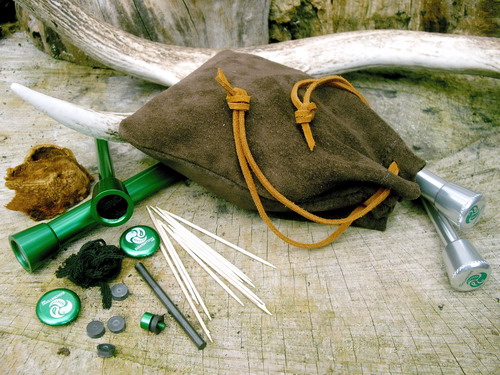
What is a Fire Piston?
A Fire Piston is a small hand held tube – the Barrel – that has a Piston Rod – the Piston - inserted inside it. The Piston, which is allowed to freely move up and down the Barrel, usually has a Grommet of some kind that creates an air seal between the Piston and the Barrel. When the Piston is inserted in the Barrel the air that is in the Barrel is sealed inside by the Piston and the Grommet. When the Piston is the speedily pushed down the Barrel the trapped air has nowhere to escape to, and so becomes highly compressed. Rapid air compression, applying the principles of ‘Boyle's law’ in the form of a mini-Diesel engine, has a very rapid increase in temperature. Due to the speed of the compression the temperature cannot dissipate quickly enough through the walls of the Barrel and can therefor increase to a temperature to about 260°C (500°F) which is hot enough to cause certain fuel, such as Char Cloth, Amadou or Chaga Tinder Fungus, or in the case of the Diesel engine Diesel fuel types to spontaneously ignite.
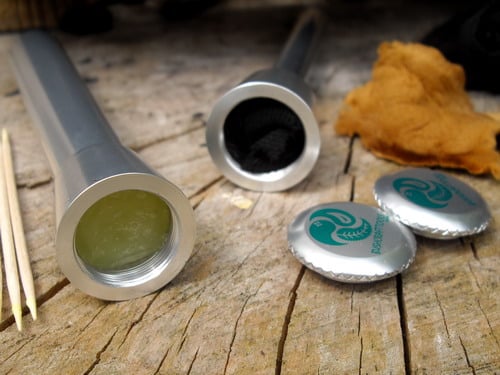 The principles of the Fire Piston were well known about long before Mr. Boyle and Mr. Diesel discovered the laws, and then constructed the first Diesel engine, by the peoples of South East Asia and Pacific Islands. The very first practical use of air compression to create fire was thought to have been discovered in those cultures where the Blow Pipe was commonly used for hunting; the theory being that whilst constructing a Blow Pipe some of the fibers created in the boring process may well have been compressed with air becoming hot enough to spontaneously ignite.
The principles of the Fire Piston were well known about long before Mr. Boyle and Mr. Diesel discovered the laws, and then constructed the first Diesel engine, by the peoples of South East Asia and Pacific Islands. The very first practical use of air compression to create fire was thought to have been discovered in those cultures where the Blow Pipe was commonly used for hunting; the theory being that whilst constructing a Blow Pipe some of the fibers created in the boring process may well have been compressed with air becoming hot enough to spontaneously ignite.
Certainly the effects of Boyle’s law are most often felt by anyone who has ever pumped up a bicycle tyre when you notice that the pump begins to get hotter and hotter as you pump air into the tyre.
How to Use a Fire Piston
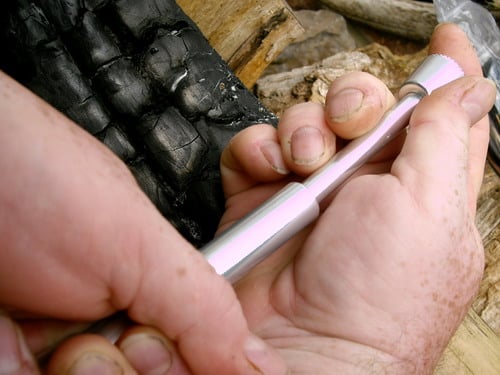
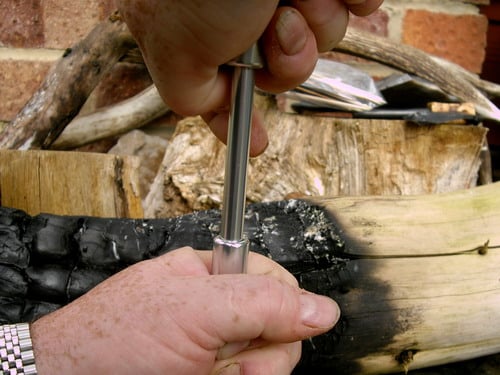

Using a Fire Piston is simplicity itself:
1) Simply place a small amount of Tinder into the Tinder Cup at the end of the Piston Rod. Making sure that it is loose, but firmly wedged in place.
2) Place the Piston Rod into the Barrel about 10mm or say ½ an inch.
3) Place the Fire Piston on a hard surface or grip it in your fist whilst supporting the base with the Ring and Little fingers.
4) Ram the Piston down the Barrel as hard as you can.
5) As soon as the Piston has been rammed home immediately, if not sooner, remove the Piston from the Barrel. It should come out with a distinct ‘Popping!’ sound.
6) Check to see if an ember has formed in the Tinder.
7) If no ember has formed repeat instructions numbers 2) through 6). Making sure that you also do the following: Turn the Barrel upside down and give it a shake to empty out any residual smoke and all replace it with fresh air. This can also be done by blowing into the Barrel, but care should be taken not to introduce spittle into the chamber. If there is still no ember you might want to check out the ‘Fault Finding - Common Faults & Issues’ described below.
8) If there is an ember place it in a previously prepared Tinder Bundle and blow it into a flame. OR place one of our Sulphur Matches against the ember and allow the Sulphur Match to ignite.
Hints & Tips
- Always keep your Tinder dry.
- Lubricate the Grommet before attempting to use the Fire Piston.
- Make sure that both Storage Caps and the Ferrocerium Rod Compartment are all firmly screwed closed before using the Fire Piston.
- Cramp Balls or King Alfred Cakes also make a good source of Fire Piston Tinder.
Fault Finding - Common Faults & Issues
Here is a list of the most common faults that are associated with Fire Pistons:
Compression Issues: - Does the Piston slide down the Barrel all of the way to the end without compressing the air (i.e. it should feel like the piston is resisting being pushed all of the way down the Barrel, getting harder to push the further it is pushed)? If compression is not taking place the Grommet may need to be re-lubricated, and or tightened/widened a fraction (see Above), and or replaced if it is too worn or damaged. If compression is taking place check the following:
Checking for smoke: - Take a look down the Piston’s Barrel to see if the chamber is full of smoke; if it is full of smoke then ignition is taking place; the issue may therefore be due to the Tinder being spent, and or the Tinder may be too damp to hold an ember, and or you are not removing the Piston from the Barrel quickly enough.
If the chamber has no smoke in it there may be compression issues (see above), and or the Tinder may be spent, and or damp, and or you are not replacing the spent air between strokes.
Unsuitable Tinder: - When your Tinder is not suitable for use with a Fire Piston it will make no difference as to what you do the Tinder will not ignite because it is not suitable for use with a Fire Piston. Replace the Tinder with some of the following examples of fantastic Fire Piston Tinder:
1) Amadou Tinder Fungus
2) Chaga Tinder Fungus
3) Char Cloth - good quality must be made from 100% Natural fibres, such as Cotton or Linen etc. Man-made and mixed fibres will not work.
4) King Alfred Cakes also known as Cramp balls work quite well.
Incorrectly Packed Tinder: - The Tinder may be packed too tightly for air to get to the ember as it is removed from the Barrel; Tinder should be loosely but firmly packed into the Tinder Cup so that it will not fall out as the Piston is rammed home down the Barrel.
Overly Humid or Wet Weather Conditions: - Sometimes the air is just too humid for an ember to be successfully created; whilst this rare it is worth consideration if all else fails … it might not be your fault. If you can’t get an ember simply unscrew the Piston Rod from the Storage compartment, remove the Ferrocerium Fire Steel Rod and land a spark on your dry tinder with this alternative ignition source.
Additional Tinder
We offer standard Rubber Grommets or Traditional Leather Grommets for this Fire Piston should they ever be required.
We also supply a wide selection of various forms of Tinder that have been successfully tried and tested by us, over the decades, to create many thousands of fires. Please see ‘Tinder Options’ (above) to select additional supplies.

